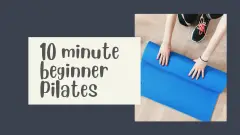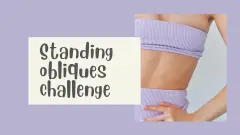We all want flat, toned abs, but if time’s short then calorie burning cardio often takes priority. Giving priority to cardio isn’t a bad thing, because it’s the type of exercise that is most likely to have a positive impact on health. However, there are many benefits to training the core muscles (see below). If you want to do a quick ab workout, then try one of these 3.
The benefits of ab workouts
- Strong abs help to prevent back pain and injury
- Strength and balance in the abdominal muscles is key to good posture
- Strong abs help you do most forms of exercise with better technique, improving results and decreasing the risk of injury
- As you get used to focusing on the ab muscles, you start to naturally engage them more during exercise and every day activities, improving them even further
- Finally, better ab tone looks good!
3 quick ab workout routines to choose from
There are 3 workouts in this post. Each of them should take 5 minutes or less. It’s best to do these exercises on a soft surface – if you don’t have an exercise mat, a folded blanket or quilt will be fine. The instructions are below, with a chart for each workout showing reps/how long to hold for. See the end of the post for the workout chart. Before you do these workouts, please read these general safety guidelines.
You will need some form of cushioning for your spine, ideally an exercise mat. See a mat buying guide here.
Workout #1: Basic and reverse curl
Ab curls and their variations work the top layer of abdominal muscles – the 6 pack. Their job is to flex the trunk towards the legs – like when we bend over. They aren’t involved in stabilising the pelvis as much as the deeper muscles. Because they are more visible, they’re often the ones people want to work. These are the two standard exercises for the 6 pack muscles.
How to do a basic crunch
- Lay with knees bent, feet flat on the floor about hip distance apart.
- Put your hands behind your head to prevent neck strain.
- Engage your abdominal muscles and curl your spine smoothly away from the floor.
- Stop when the shoulder blades have left the floor and start to reverse the movement.
How to do a reverse crunch
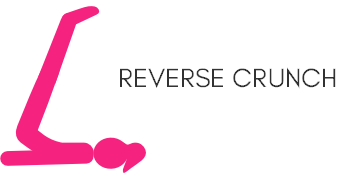
- This time, start by extending your legs so that they are vertical.
- Engage your lower abs as you curl your lower spine off the mat. Again, it should be a smooth curling movement.
- When your lower back has left the floor, start to reverse the movement – curl the spine back down under control.
Sets & reps for this routine
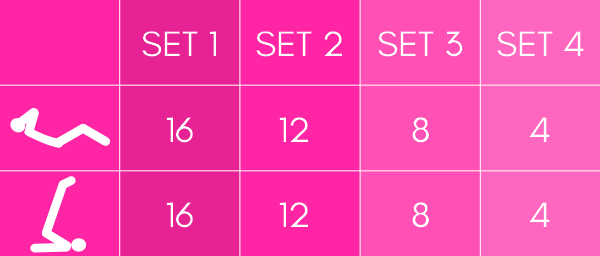
Workout # 2: Arm and leg raises, elbow plank hold
Being able to stabilise the pelvis is key to successful ab training. The core abdominal muscles should work together to keep the pelvis in its “neutral” position – that is, not tilting forwards or backwards. When the core muscles are out of condition, the pelvis is often a permanent forward tilt. These two exercises focus on the core stabilising muscles.
How to do the arm and leg raise

- The starting position for this is all-4 kneeling.
- Keeping your abdominal muscles pulled in, lift your opposite arm and leg until they are parallel with the floor.
- Keep your back flat and your body steady. Hold for the given number of seconds.
- Lower and repeat on the other side.
How to do an elbow plank

- Kneel on the floor.
- Lean forwards and put your forearms on the floor, making sure your shoulders are directly above your elbows.
- Straighten one leg out behind you, with the toes on the floor.
- Engage your core strongly and extend the other leg behind.
- Now hold this position for the given number of seconds.
Sets & reps for this routine
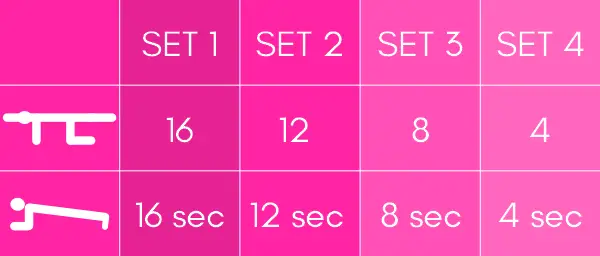
Workout #3 Oblique crunches and hip rolls
The oblique muscles are involved in twisting and side bending movements, as well as playing a part in pelvic stability and pulling the abdominal area in flat. Both of these exercise mainly work the obliques.
How to do an oblique crunch

- Lie on the floor with your legs together, bent to 90° at the hips and knees.
- Take your hands behind your head, with your elbows relaxed out to the sides.
- Rotate your left elbow towards your right knee. It doesn’t matter if you can’t lift your shoulder high enough for your elbow to touch your knee, just get it as close as you can. Your left shoulder blade should lift up, but the right stays on the floor.
- Now lower the left shoulder blade back to the floor and lift your right elbow towards your left knee.
How to do hip rolls

- Start by lying on the floor, with your legs bent at the hips and knees as shown. Your arms should be out to the side, level with your shoulders
- Engage your abdominal muscles and then rotate your legs to the right. It’s important to keep the abs engaged and control the movement. Only take your legs as far as you can keep the movement controlled.
- When you have lowered your legs as far as you can, begin to reverse the movement. When you get back to the starting position, start again in the other direction.
Sets & reps for this routine
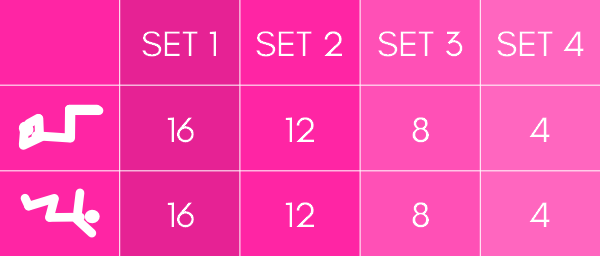
Related to quick ab workout
Ab workouts FAQ
The stock answer to this is that you can’t get rid of fat from a specific area. This is repeated frequently and emphatically by almost everyone involved in fitness. Given that it’s the go-to answer, you would think that there’s a pile of evidence to support it. In fact, the evidence is surprisingly weak. On the other hand, there’s no evidence that you can exercise to burn fat from a specific area either.
What we do know for sure is that our bodies have preferred places to store fat – and the abdominal area is one of them. So you’re not likely to have a fat-free belly until you’re a healthy weight. The best way to be a healthy weight is of course to have a healthy diet and to exercise regularly. Any exercise helps with weight control.
Even if it doesn’t burn belly fat, regular ab exercise will make a difference though. The deep core muscles pull the abdominal area flat and having a strong core can make a real difference. In fact it’s often the case that what people think is fat is just poor muscle tone allowing the abdomen to protrude.
So, the best things you can do to look slimmer around your middle are to make sure you’re a healthy weight and do some core training.
Last Updated on: May 20, 2022Plank holds have been an enormously popular abs exercise for years now. This is probably due to the buzz surrounding the exercise in the form of challenges and extreme hold times, rather than being due to its merits as an effective exercise.
Done correctly, the plank will engage the deepest abdominal muscle, the transverse abdominis (TA). This is the one that plays the biggest part in pulling the abdominal area in flat, as well as playing an important role in pelvic and spinal stability. It’s a challenging exercise and most people will struggle to hold the correct position for more than a minute. These are the good points. However, the plank has its drawbacks:
- Doing it with correct technique is difficult for those who are not used to core training. To be effective, the back and legs must form a straight line (like a plank). Inexperienced exercisers fail to do this.
- It’s a static exercise (ie the muscles are held contracted). There are two problems with static exercises. One is that the muscles are only worked in one position and the other is that it causes blood pressure to increase.
- It’s not functional – we do nothing vaguely resembling the plank in every day life. If we want to train our TA to engage when we’re active, then holding it in a static contraction isn’t the best way.
So should you do plank holds? Yes, it’s good to add them to your abs routine sometimes or to do a plank challenge for variety. But you should make sure your technique is correct and you shouldn’t waste your workout time trying to build up excessively long holds.
As with most “best exercise” questions, the answer depends on what you’re trying to achieve. The two main goals people have are flat abs and 6 pack abs. To have a flat abdominal area you need to train the deeper abdominal muscles. This is done by doing core stabilising exercises. The 6 pack muscles are the top layer of ab muscles and are trained by crunches and similar exercises – any exercise in which the upper body and lower body come closer together against a resistance. If you want to train all your ab muscles, bicycle crunches are a good all-round exercise.

